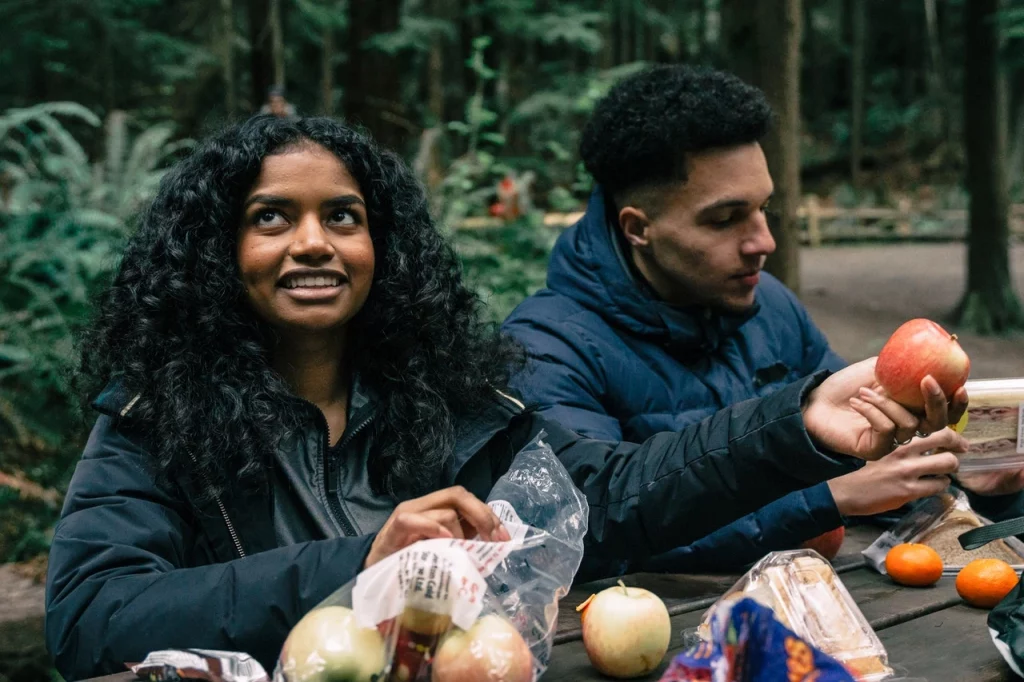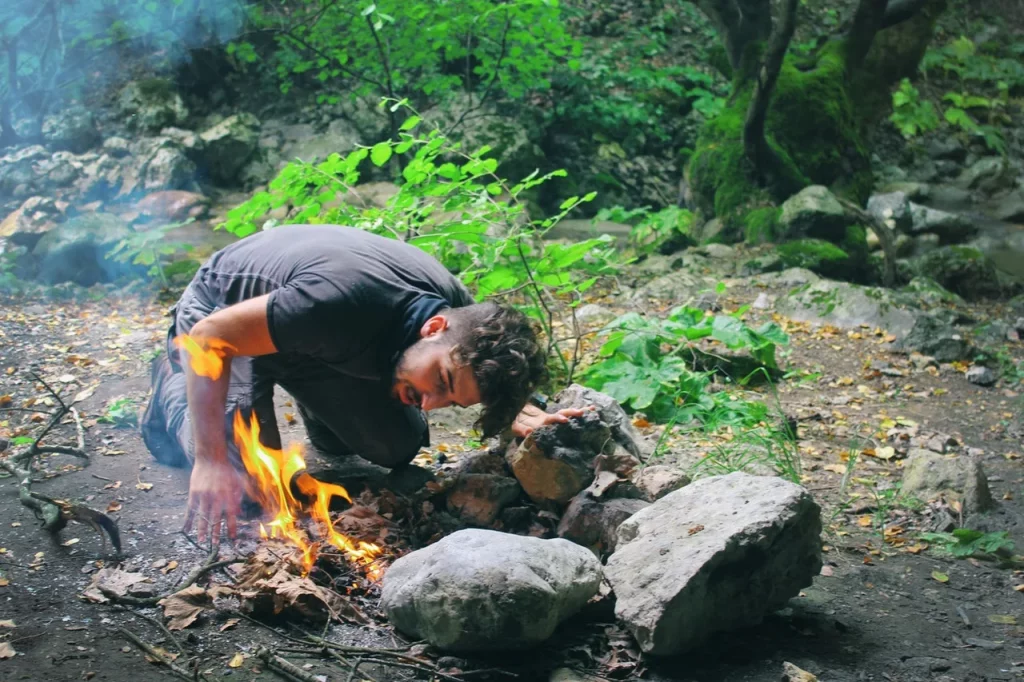Hiking is one of the most popular outdoor recreation activities in the United States. According to a data analysis of hiking trail apps, activity on these paths increased by 171.4 percent in 2020 compared to the previous year. If you want to experience the great outdoors by exploring hiking trails near you, there are plenty of things you need to know.
This beginner’s guide will help you navigate hiking trails safely, assist you in choosing basic hiking gear and tell you if you should try bushwhacking.
What are Hiking Trails?

Hiking trails are established pathways through wilderness or park areas. These paths are built and mapped out to ensure people can easily navigate them when compared to off-trail hiking. There are over 193,000 miles of trails on federal lands, and an additional 42,500 miles of trails established on state lands.
These trails generally fall into two categories: scenic trails and historic trails.
- Scenic Trails
Scenic trails are paths that were laid down to enhance your appreciation of an area’s natural beauty. Scenic trails do not necessarily mean they are easier to navigate, as there are different types of scenic trails depending on the terrain. Expect a scenic trail to take you near a lovely lake, cross a picturesque brook or cut through a meadow of wildflowers. Scenic trails are significantly shorter than historic trails.
- Historic Trials
Historic trails are a rare type of hiking trail, and they are not ideal for bushwhacking. Historic trails are established in areas of historic significance to the state or to American heritage. These trails can be hundreds, even thousands, of miles long. They follow the real-life pathways taken by pioneers, adventurers and other notable figures in America’s past.
One of the most famous historic trails is the Oregon Trail, which traverses over 2,000 miles across 7 states. A beginner hiker such as yourself may travel a handful of miles along one of these hiking trails.
How Can You Navigate Hiking Trails Safely?

Hiking is a recreational activity, but then so is football. There are inherent risks to engaging in any outdoor recreation activity and the more prepared you are, the less likely that you’ll meet with an unfortunate incident on hiking trails.
Below are some basic rules you should abide by when you are a beginner hiker.
- Inform Friends and Authorities
Before you even take one step on a trail, you need to tell friends where you’re going. Inform them which hiking trails you plan on going to, how long you expect to stay outdoors and when you should be back.
Relay this information to relevant authorities such as park rangers and forest rescue services. This ensures that even if you accidentally foray into off-trail hiking and get lost, people will know where and when to start looking for you.
- Stay on Trail
Don’t tempt fate by straying from established paths. Studies have shown that many hikers get lost and have to be rescued because they strayed from their paths. More accidentally left their hiking trails because they fell from them or did not know they were already straying. Keep a careful eye on the trail and never let it out of your sight.
- Check the Weather
Inclement weather can be very dangerous to both experienced and beginner outdoor enthusiasts. Before you go on your trip, see what kind of weather you may expect in the next two days. Heavy rain can turn normally easy trails into muddy slogs and even wash them away, potentially stranding you. Snow and severe heat waves also turn hiking trails into grueling exercises instead of pleasant experiences. So check the weather and adjust your plans accordingly.
- Do Your Research
Trails are unique and each one can require different hiking gear from another. There’s also the question of what sort of vegetation and poisonous animals you may encounter while you’re on the trail. Talk to other outdoor enthusiasts who have been on the trial before.
Check forums about hiking trails and see what they have to say about the trail. Even an hour of dedicated research can help you prepare yourself as best as you can from anything the trail has to offer.
- Get a Guide
Beginners should never venture out into a trial alone, especially if you are planning a prolonged hiking trip. There are plenty of private services that offer guides along established trails and their help can be invaluable. Some guides even come with basic training exercises such as how to best wear a camping backpack and strow your gear.
- Choose an Appropriate Trail
Never overestimate what you are capable of, especially if you are a beginner. Find trails that are only a few miles long to ensure you don’t overexert yourself or wander too deep into the wilderness. Elevation and steepness are other considerations as the higher and steeper the hiking trail, the harder it will be for you to traverse it. Build your strength and outdoor experience first before committing to exploring harder trails.
- Consider Your Health
Check with a physician beforehand if you can safely travel along a trail in your current physical condition. If you have heart disease or similar conditions, overexertion can be dangerous. There are other conditions that you need to check with a doctor before you go out on hiking trails, such as respiratory ailments, allergies and chronic conditions. Have yourself cleared by your doctor to prevent experiencing a medical emergency outdoors.
- Train Beforehand
Some trails can be physically rigorous and it is inadvisable to attempt them without some training. You don’t have to become an expert or anything to successfully navigate a hiking trail, but two weeks on a treadmill and a staircase machine can enhance the experience. It will also prevent you from getting exhausted too early in your hike.
What Should Bring on a Hiking Trail?

Bringing the right hiking gear can mean the difference between safely making down a trail and having a difficult and maybe even a life-threatening experience. You should carefully catalogue what items you must bring with you, even on a short hike. Some equipment pieces are specifically made for different people that could help make carrying them easier.
For example, hiking gear for women is designed to be lighter and fit on smaller frames.
Below are some essentials you must always bring when you go on hiking trails.
- Protective Clothing
There are plenty of things that may irritate or harm you along any trail. From scratching thorns to sharp rocks and even venomous animals, any outdoor enthusiast or bushwhacker will tell you your clothing is essential. This includes sturdy shoes or boots, long pants to prevent insect bites and a brightly colored vest, which are required during hunting season. Protection from the sun like a hiking hat is also essential to prevent heat exhaustion and sunburns.
- Water
The average human requires anywhere between 2.7 to 3.7 liters of water, depending on their sex and other factors. You should always carry plenty of water in a thermos or a canteen. A 1-liter can is enough for a short hiking trip that will last maybe half a day. More will be necessary for longer trips. If your hiking trail contains streams and rivers, do your research if these waterways are safe and bring equipment that can help purify the water just in case you need more.
- Navigational Aids
Never go out into a trail without waterproof maps of the trail, maps of the surrounding region, a compass and ideally some form of GPS tracker. Don’t rely on your phone’s navigational capabilities as it is highly unlikely there would be excellent cell reception or internet signals outdoors. These navigational tools can be essential if you get lost.
- Food
Just like you can’t exist without water, you should always pack your own food. Even experienced outdoor enthusiasts and bushwhackers bring as much of their own food as they can before trying to live off the land. Beginners should not even attempt to get food from nature as you will not have the same knowledge to determine if something is safe to eat or not. Bring food that lasts long without refrigeration and focus on food that can give you energy such as proteins and sugars.
- First Aid Kit
A basic first aid kit can go a long way when you’re out on a hiking trail. A small cut can easily become infected if left unattended. A scratch can slow you down and cost you valuable daylight hours without some first aid. A basic first aid kit should contain bandages, an antiseptic, some form of antihistamine or epinephrine in case of allergies, and basic medications for pain, flu and to fight against infection.
Should You Try Bushwhacking?
If you’ve been researching hiking trails and outdoor exploration in general, you may have come across the term bushwhacking. This refers to hiking outside of established trails. Needless to say, off-trail hiking is an activity that should only be attempted by experienced hikers. There are already many risks you take when you go on an established trail and going off of it can be very dangerous. If you are a beginner, do not attempt bushwhacking for any reason. Stay on the trail you’ve chosen and keep it in sight at all times.
The great outdoors has much to offer people and hiking trails are some of the best starting points. These tips will help protect you from some of the worst dangers out there and give you a new appreciation of nature.

